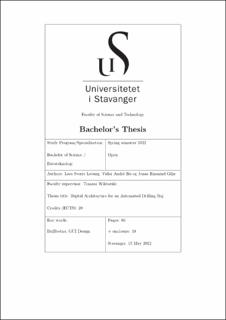| dc.contributor.advisor | Wiktorski, Tomasz | |
| dc.contributor.author | Bø, Vidar André | |
| dc.contributor.author | Levang, Lars Sverre | |
| dc.contributor.author | Gilje, Jonas Emanuel | |
| dc.date.accessioned | 2022-07-02T15:51:16Z | |
| dc.date.available | 2022-07-02T15:51:16Z | |
| dc.date.issued | 2022 | |
| dc.identifier | no.uis:inspera:93568650:50804471 | |
| dc.identifier.uri | https://hdl.handle.net/11250/3002317 | |
| dc.description.abstract | The objective of this thesis was to develop the digital architecture for a
small-scale drill rig intended for use by the Drillbotics team at the Uni-
versity of Stavanger, for an international student competition by the same
name. The main goals of the project has been to develop a robust software
architecture, data acquisition system, data management system and graphi-
cal user interface. The main criteria are the guidelines given by competition
organisers, criteria given in the thesis description, and criteria given by the
Drillbotics team.
We created a system for communication between the computer, programmable
logic controller and the drill rig such that we can communicate between
platforms using the CAN protocol. With this communication in place,
both the data acquisition logging and control system can operate without
delay. Any data retrieved is stored in a data management system, as per
competition guidelines. The database has been stress tested and has a 15x
safety margin between operation- and top speed, ensuring the database will
not be a bottleneck.
The main human machine interface for the drill rig, the graphical user
interface, on the computer was developed using principles researched in
advance to ensure an interface that was based on good industry practices.
The big focus on researching proper methods of making the interface is due
to the competition recently adding human machine interface as a major
judging criteria in the competition.
A system has also been developed that covers models used for steering the
directional drilling according to the industry standard minimum curvature
method. The path given by the minimum curvature method is the ideal
path that we try to follow. The path also has safety margins given to it to
ensure the rig never strays too far from the path.
The systems created in this project have had a side-goal of being scalable
and using good abstractions such that it is able to be used by future Drill-
botics teams, for both future computer science bachelor groups, or the rest
of the team as well. | |
| dc.description.abstract | The objective of this thesis was to develop the digital architecture for a
small-scale drill rig intended for use by the Drillbotics team at the Uni-
versity of Stavanger, for an international student competition by the same
name. The main goals of the project has been to develop a robust software
architecture, data acquisition system, data management system and graphi-
cal user interface. The main criteria are the guidelines given by competition
organisers, criteria given in the thesis description, and criteria given by the
Drillbotics team.
We created a system for communication between the computer, programmable
logic controller and the drill rig such that we can communicate between
platforms using the CAN protocol. With this communication in place,
both the data acquisition logging and control system can operate without
delay. Any data retrieved is stored in a data management system, as per
competition guidelines. The database has been stress tested and has a 15x
safety margin between operation- and top speed, ensuring the database will
not be a bottleneck.
The main human machine interface for the drill rig, the graphical user
interface, on the computer was developed using principles researched in
advance to ensure an interface that was based on good industry practices.
The big focus on researching proper methods of making the interface is due
to the competition recently adding human machine interface as a major
judging criteria in the competition.
A system has also been developed that covers models used for steering the
directional drilling according to the industry standard minimum curvature
method. The path given by the minimum curvature method is the ideal
path that we try to follow. The path also has safety margins given to it to
ensure the rig never strays too far from the path.
The systems created in this project have had a side-goal of being scalable
and using good abstractions such that it is able to be used by future Drill-
botics teams, for both future computer science bachelor groups, or the rest
of the team as well. | |
| dc.language | eng | |
| dc.publisher | uis | |
| dc.title | Digital Architecture for an Automated Drilling Rig | |
| dc.type | Bachelor thesis | |
